The Best Line For Salmon Fishing In Rivers
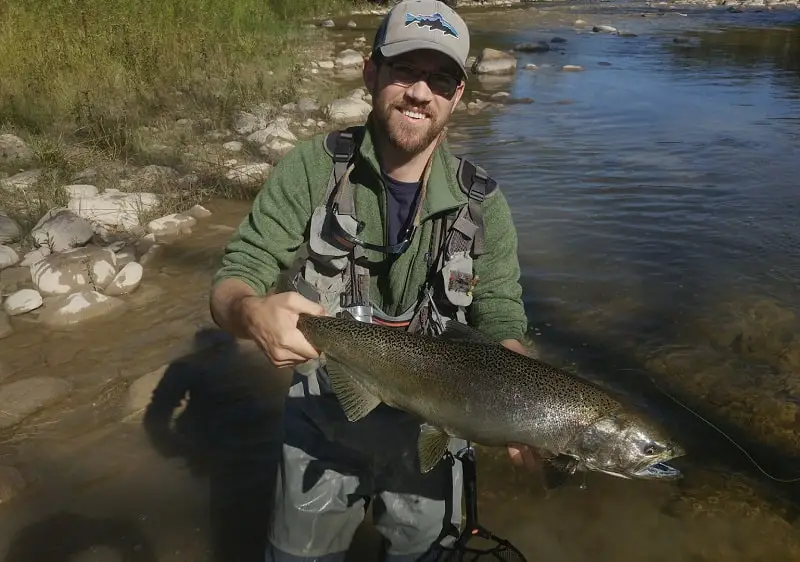
After fishing for salmon for over 37 years and guiding for salmon for the last 22 years, I have had the opportunity to test out a lot of lines for salmon fishing under all types of conditions and with all methods.
Best Lines For Salmon By Method
- Casting lures: Braided line is the best line for casting lures.
- Float fishing with spinning reel: Sufix Elite monofilament is the best line for float fishing using spinning reels
- Centerpin fishing: The best line for centerpin fishing is Raven Mainline
- Plunking: The best line for plunking is Fluorocarbon
- Back trolling: Braided line is great for back trolling.
There are reasons why these lines work best, but there are other lines that can also be used. Top guides and anglers will use lines that best match the type of water, the method, and the size of the salmon, and you should too.
The Best Line For Salmon Fishing
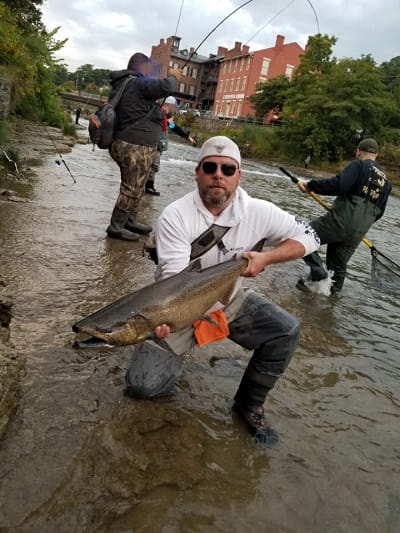
There are four types of lines used for fishing salmon in rivers. Each has advantages and disadvantages.
Anglers will argue that one is better than another, but often, these arguments are based on personal opinion and the angler’s preference.
I’m going to be as unbiased as possible and tell you the pros and cons of each line. I will then tell you what I use, what most guides are using, and why.
What Pound Line For Salmon In Rivers
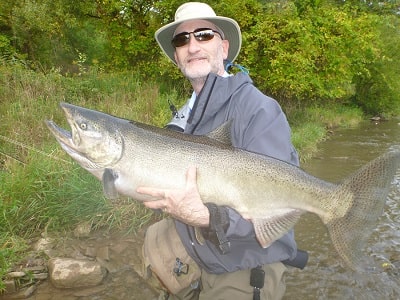
The best line size for salmon is 12 to 16 pounds. An 18- to 20-pound line may be more suited to very large rivers with very large salmon, such as those in Alaska. These are general guidelines.
Some anglers even use lines up to 40 pounds for certain methods.
| Fishing Technique | Environment | Recommended Line Size |
|---|---|---|
| Float Fishing | Small Streams | 10 to 12 pounds |
| Float Fishing | Medium-sized Rivers | 12 pounds |
| Float Fishing | Large Rivers | 14 to 16 pounds |
| Casting Lures | Small Streams | 12 to 14 pound mono, 20 to 30 pound braided line |
| Casting Lures | Medium Rivers | 14 pound mono, 20 to 30 pound Braided line |
| Casting Lures | Large Rivers | 16 pound mono, 30 pound Braided line |
| Plunking | – | 20 pound Fluorocarbon |
| Back Trolling | – | 40 pound mono or 40 to 65 pound braided line |
I tend to always use the lightest line possible. Most anglers use mainlines that are far too heavy.
In many cases, I believe your mainline should be only two to four pounds heavier than your strongest leader.
There is no point using 30-pound mainline when your maximum leader size is 14 because it’s going to break at 14 pounds.
I’d rather use a thinner line so I can pack more lines onto my reel. Thicker lines also cast better and are more manageable. When float fishing, the thinner line sags less and is more buoyant, which is all good for presentation.
Also, based on my testing, most mainlines are much heavier than they say on the package.
General Breakdown Of Line Sizes For Salmon In Rivers:
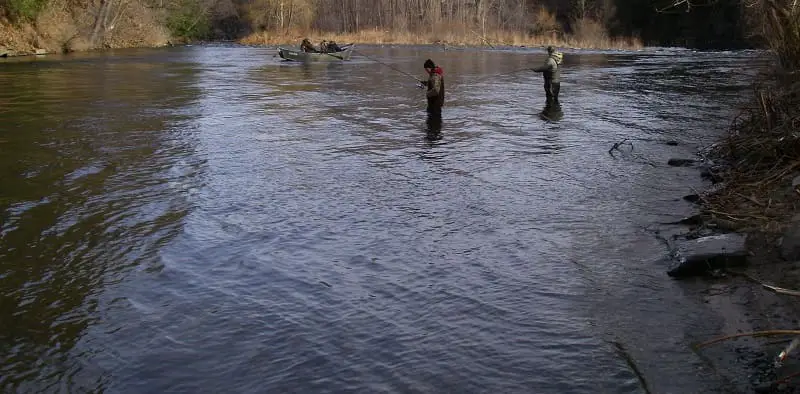
How to Choose The Best Line Size For You:
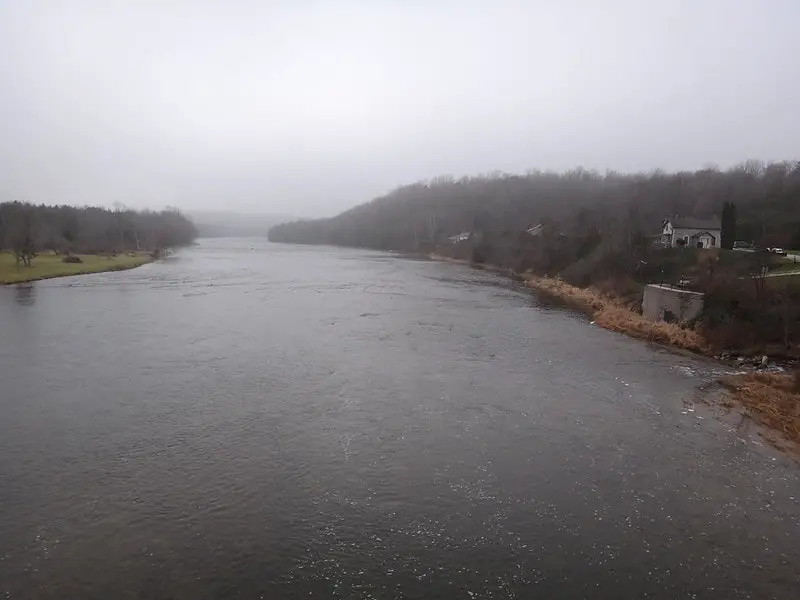
If your river is small and clear or slow, and you have the ability to walk up and down the river to chase a salmon that you have hooked, then the smaller size of 10 pounds is plenty.
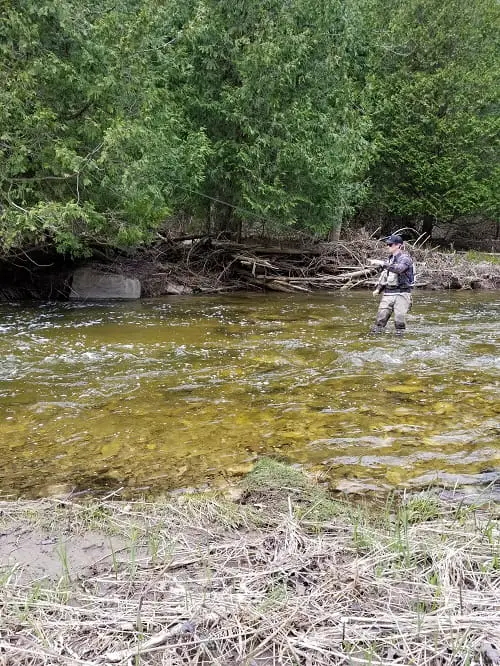
If that same river has lots of wood and rocks or is fast flowing, or you primarily cast lures, then upsize to a 12 or 14-pound line.
If you fish very large rivers or fast rivers where the salmon will use the current to help them, go with a much heavier line.
If the river is 500 feet across or you can’t walk the banks easily to chase a salmon, go with a line in the 16 to 20-pound size, especially if you are casting lures.
Fluorocarbon Line
Fluorocarbon lines are good for lure fishing, plunking, drift fishing, and bottom bouncing methods. They should not be used when float fishing.
Pros
- Fluorocarbon lines are less visible under the water
- Fluorocarbon tends to sink
- Fluorocarbon is very abrasion-resistant
- Does not absorb water like braided lines.
- It’s not affected by UV rays
- Less stretch on hook sets
Cons
- Fluorocarbon lines are less subtle and can cause line issues on the reel. I discuss these issues below. Line problems are less of an issue if you use good quality lines designed for casting and used and tested by guides and pro anglers.
- It’s more expensive compared to monofilament lines and some braided lines.
The Best Fluorocarbon Lines For Salmon Fishing
Conclusion: Fluorocarbon is the best line to use for more advanced anglers when drift fishing, bottom bouncing due to its invisibility and abrasion resistance, and sink rate. It’s also the best for casting lures if you don’t want to use a leader, meaning you want to tie the line directly to the lure or a snap swivel.
- #1. Seaguar InvizX Fluorocarbon Line – Check Price
- #2. Sunline Super FC Sniper Fluorocarbon Line – Check Price
Braided Line
Braided lines are being used more and more by professional and amateur anglers, and for good reason. It is exceptionally strong for its super thin diameter, and it has almost no stretch, which makes braids a good line for catching salmon.
A thin diameter is generally a good thing, as long as it’s strong. With braided lines, a 20-pound braided line has about the same diameter as a 6-pound fluorocarbon or mono line.
These thin lines are great for lure fishing and some anglers really like them for float fishing purposes.
Pros Of Braided Line
- The thin lines cut through the water when using lures, which can get your lure deeper.
- There is literally no stretch with braided lines, which improves hook penetration (can be good or bad).
- Braided lines float or are more buoyant than mono or fluorocarbon. Floating lines are a benefit when float fishing.
- Because the braided line is so thin, you can fit a lot more line on the reel for those long runs.
- Braided lines last longer than mono.
- Braided lines tend to be more sensitive, which is great for methods like Drift Fishing, Bottom Bouncing, and Jig Fishing for Salmon. Use a fluorocarbon Leader.
Cons
- Braided lines are the most visible line to the fish, therefore leaders are almost always required when lure fishing and when float fishing.
- Braided lines are more expensive than mono.
- Some anglers have issues with line wrapping around the tip more often with a limp braided line.
- Braided lines require special knots. Some knots will slip with a braided line.
- The braided line needs to be properly installed and secured to the reel spool or it can slip and spin freely.
- Braided lines can freeze when fished in below-freezing temps because they absorb water. For this reason, most anglers won’t use braids in winter.
- Braided line has been known to cause grooves in the eyes of some rods, which can damage the guides and cause line breaking.
- Anglers often find they will rip hooks out of the fish’s mouths on hooksets due to zero stretch.
- Anglers find they are more likely to break fish off on the hookset, or they break fish off when the fish gets close due to no stretch.
When lake fishing with lures, I almost always use braided lines. I also mostly use braided lines when Lure Fishing For Salmon in rivers.
I do not recommend braided lines for Plunking For Salmon since the lines are too visible to the fish unless you use a long fluorocarbon leader.
What Pound Braid Is Best?
Because the diameter of the braided line is so thin, I tend to go a bit higher in weight. A 20-pound braid is often ideal for most situations and methods, with its diameter being closer to a 6-pound test.
20 to 30-pound braided line for salmon should be plenty for almost all lure fishing and float fishing purposes. I stick with 20 pounds when float fishing because it’s very light and floats well.
However, I would not go with a 10-pound braid, which is around 2 to 4 pounds, simply because with such a thin diameter, it is more prone to breaking should you hit rocks.
Conclusion: Although rarely used, braided lines are the best line for float fishing for advanced anglers in weather above freezing air temps. It is also the best line when lure fishing if you are ok with using a fluorocarbon leader.
If you use braided lines, be sure to adjust your methods, meaning, do not set the hook as hard with lighter leaders, use braided lines that do not tip-wrap as much, watch for grooves in your rod guides or use braids that cause fewer issues.
Good Braided Line Options:
- Berkley FireLine Thermally Fused Superline 20 lb – Check Price
- Sufix 832 Advanced Superline 20 lb – Check Price
Copolymer Line
Some anglers and guides will use copolymer lines when lure fishing, drift fishing, and bottom bouncing for salmon with baitcasting reels, but many anglers do not like it on spinning reels.
Based on what I have read and seen, some copolymer lines can have too much coil causing it to twist or jump off the spinning reel spools.
Copolymer lines are also not great for float fishing due to them sinking faster and not floating well.
Conclusion: I believe that there are other lines that are better for most situations and therefore do not use or recommend Copolymer lines for river fishing for salmon.
Monofilament Line
Monofilament lines, also known as mono, are the most popular lines and are used by most salmon anglers for a few reasons.
Mono is a great all-purpose line and can be used effectively with just about any method and this makes mono lines a good line for salmon fishing.
Mono is cheap, it’s readily available, and it comes in many brands, and for that reason many anglers prefer it.
Mono has also been around for a long time, longer than all the other lines, so the old-school boys tend to stick with what they know. Also, for many anglers, mono is what they started fishing with as kids or new anglers, and it’s what they know and stick with.
Lastly, mono tends to be more buoyant, and therefore it is likely the best option when float fishing for salmon.
The cons of mono include being less abrasion resistance, less line memory, and it tends to stretch more than the other lines. Mono is also more visible to the fish than fluorocarbon.
I mostly use mono lines when float fishing and centerpin fishing because it floats, (not all mono lines float well), it comes off the reel easily, as well as how well it handles when fishing. This is important for me as a guide who teaches hundreds of anglers a year.
Many anglers prefer mono because the extra stretch is less likely to rip hooks out of mouths during the fight and on the hookset. It also helps protect lighter leaders from breaking.
Conclusion: Mono is likely the best line for beginners. However, depending on the method you use and your skill level, mono is not always the best line.
Proven and Trusted Monofilament Lines For Steelhead:
- Sufix Elite Premium Monofilament Line – Good as a multi-purpose line.
- Raven Main Line Monofilament Line (mostly used for float fishing).
If you are new to salmon fishing, be sure to check out How To Catch Salmon In A River.
Tight Lines,
Graham

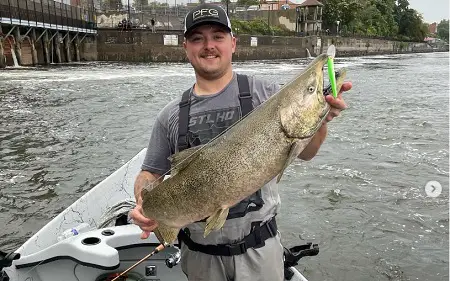
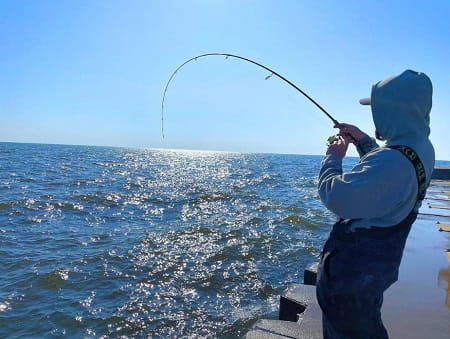
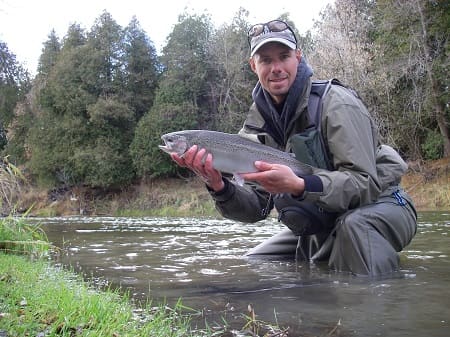
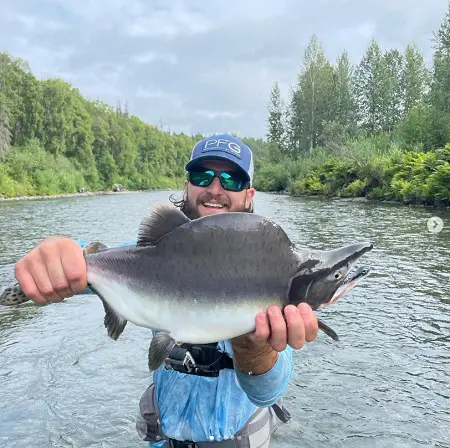
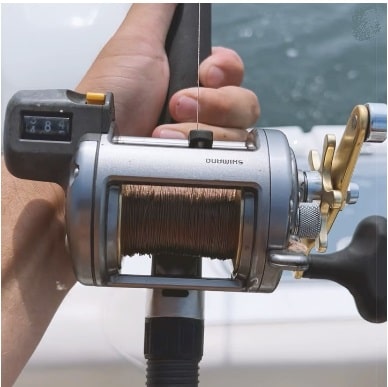
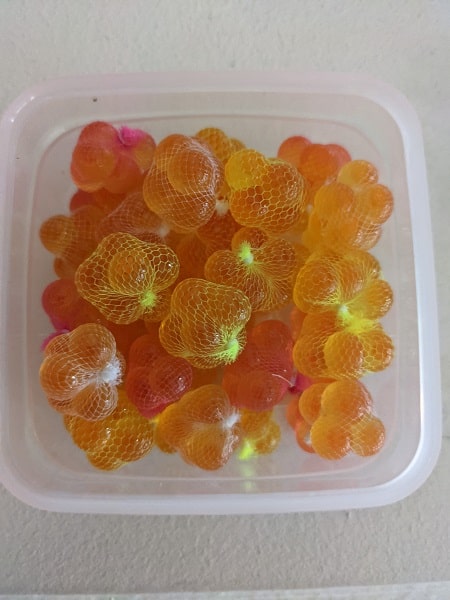
Great article!! I fish 18 pound line on the Quanault River in the Olympic National Forest in Washington State. Big Steelhead…… that will pull your boat around!!
Keep writing and stay safe!
Fred Easton is the guide I use on the Quanault River system in Washington State. Starting on my 30th (thirty) Steelhead over 25 pounds. I have only killed one fish over 25 pounds! It was 32 pounds, 42.1/2 inches long…Wow!!
Hey Martin,
It’s good to know your river and your fish so you can choose your line appropriately. Thanks for the advice and good luck this fall..
what’s the best pole length for samon &stealhead
Hey Lance,
The answer really depends on the fishing methods you will be using.
For float fishing, I use 13 and 14 foot rods.
For Drift fishing 11 to 13 foot rods.
For lures,
7.6″ to 9’6 are good options.
You can see more details at Best Salmon Rods For River Fishing.
Good Luck
Graham